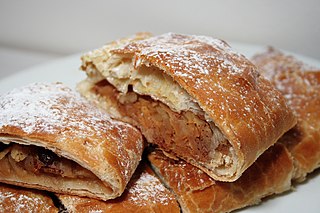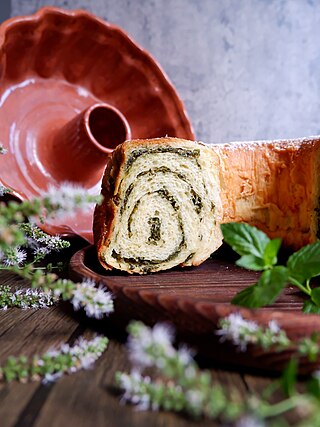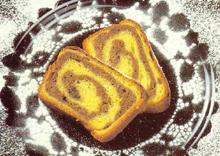
Apple strudel is a traditional Viennese strudel, a popular pastry in Austria, Bavaria, the Czech Republic, Northern Italy, Slovenia, Croatia, and other countries in Europe that once belonged to the Austro-Hungarian Empire (1867–1918).

Filo is a very thin unleavened dough used for making pastries such as baklava and börek in Middle Eastern and Balkan cuisines. Filo-based pastries are made by layering many sheets of filo brushed with oil or butter; the pastry is then baked.

A hamantash is an Ashkenazi Jewish triangular filled-pocket pastry associated with the Jewish holiday of Purim. The name refers to Haman, the villain in the Purim story. In Hebrew, hamantashen are also known as אוזני המן, meaning "Haman's ears". "Haman's ears" also refers to a Sephardic Purim pastry, "Orejas de Haman", thought to originate in Spain and Italy, that is made by frying twisted or rolled strips of dough.

Strudel is a type of layered pastry with a filling that is usually sweet, but savoury fillings are also common. It became popular in the 18th century throughout the Habsburg Empire. Strudel is part of Austrian cuisine and German cuisine but is also common in other Central European cuisines. In Italy it is recognized as a prodotto agroalimentare tradizionale (PAT) of South Tyrol.

Banitsa, also transliterated as banica and banitza, is a traditional pastry made in Bulgaria. It is also made in Budjak, where it is known as milina by Ukrainian Bulgarians; North Macedonia; and southeastern Serbia. In southeastern Serbia, it may also be known as gibanica. Banitsa is prepared by layering a mixture of whisked eggs, plain yogurt, and pieces of white brined cheese between filo pastry and then baking it in an oven.

Börek or burek is a family of pastries or pies found in Ottoman cuisine. The pastry is made of a thin flaky dough such as filo with a variety of fillings, such as meat, cheese, spinach, or potatoes. A borek may be prepared in a large pan and cut into portions after baking, or as individual pastries. They are usually baked but some varieties can be fried. Borek is sometimes sprinkled with sesame or nigella seeds, and it can be served hot or cold.

Gözleme is a savory Turkish stuffed turnover. The dough is usually unleavened, and made only with flour, salt and water, but gözleme can be made from yeast dough as well. It is similar to bazlama, but is lightly brushed with butter or oil, whereas bazlama is prepared without fat. The dough is rolled thin, then filled with various toppings, sealed, and cooked over a griddle. Gözleme may sometimes be made from prepackaged hand-rolled leaves of yufka dough.

Lower Carniola is a traditional region in Slovenia, the southeastern part of the historical Carniola region. Its largest town and urban center is Novo Mesto.

Gibanica is a traditional pastry dish popular all over the Balkans. It is usually made with cottage cheese and eggs. Recipes can range from sweet to savoury, and from simple to festive and elaborate multi-layered cakes.

Potica is a traditional festive pastry from Slovenia.

A nut roll is a pastry consisting of a sweet yeast dough that is rolled out very thin, spread with a nut paste made from ground nuts and a sweetener like honey, then rolled up into a log shape. This 'log' is either left long and straight or is often bent into a horseshoe shape, egg washed, baked, and then sliced crosswise. Nut rolls resemble a jelly roll but usually with more layers of dough and filling, and resemble strudels but with fewer and less delicate dough layers. Fillings commonly have as their main ingredient ground walnuts or poppy seeds.

Slovenian cuisine is influenced by the diversity of Slovenia's landscape, climate, history and neighbouring cultures. In 2016, the leading Slovenian ethnologists divided the country into 24 gastronomic regions. The first Slovene-language cookbook was published by Valentin Vodnik in 1798.

The poppy seed roll is a pastry consisting of a roll of sweet yeast bread with a dense, rich, bittersweet filling of poppy seed. An alternative filling is a paste of minced walnuts, or minced chestnuts.

Dabby-Doughs are a type of pastry. They are traditionally made using the remnants of dough leftovers from making a pie, although they can be prepared in large amounts by simply making a batch of pastry dough. The filling of a dabby-dough is typically a mixture of cinnamon and white sugar sprinkled on butter or margarine, rolled, sliced and baked.

Štruklji is a traditional Slovene dish, composed of dough and various types of filling. The dish comes in the form of rolled dumplings, which can be steamed, boiled, or baked, and can have a wide range of fillings. Štruklji has been traditionally reserved for special occasions, but is now one of the most characteristic everyday dishes in households all across Slovenia. It is closely related to Zagorski štrukli, a traditional Croatian dish.

Pogača is a type of bread baked in the ashes of the fireplace, and later in modern ovens. Found in the cuisines of the Balkans, Levant, and Hungary it can be leavened or unleavened, though the latter is considered more challenging to make. It is generally made from wheat flour, but barley and sometimes rye may be added. It can be stuffed with potatoes, ground beef, olive, or cheese, and have grains and herbs like sesame, black nigella seed, or dried dill in the dough or sprinkled on top.














